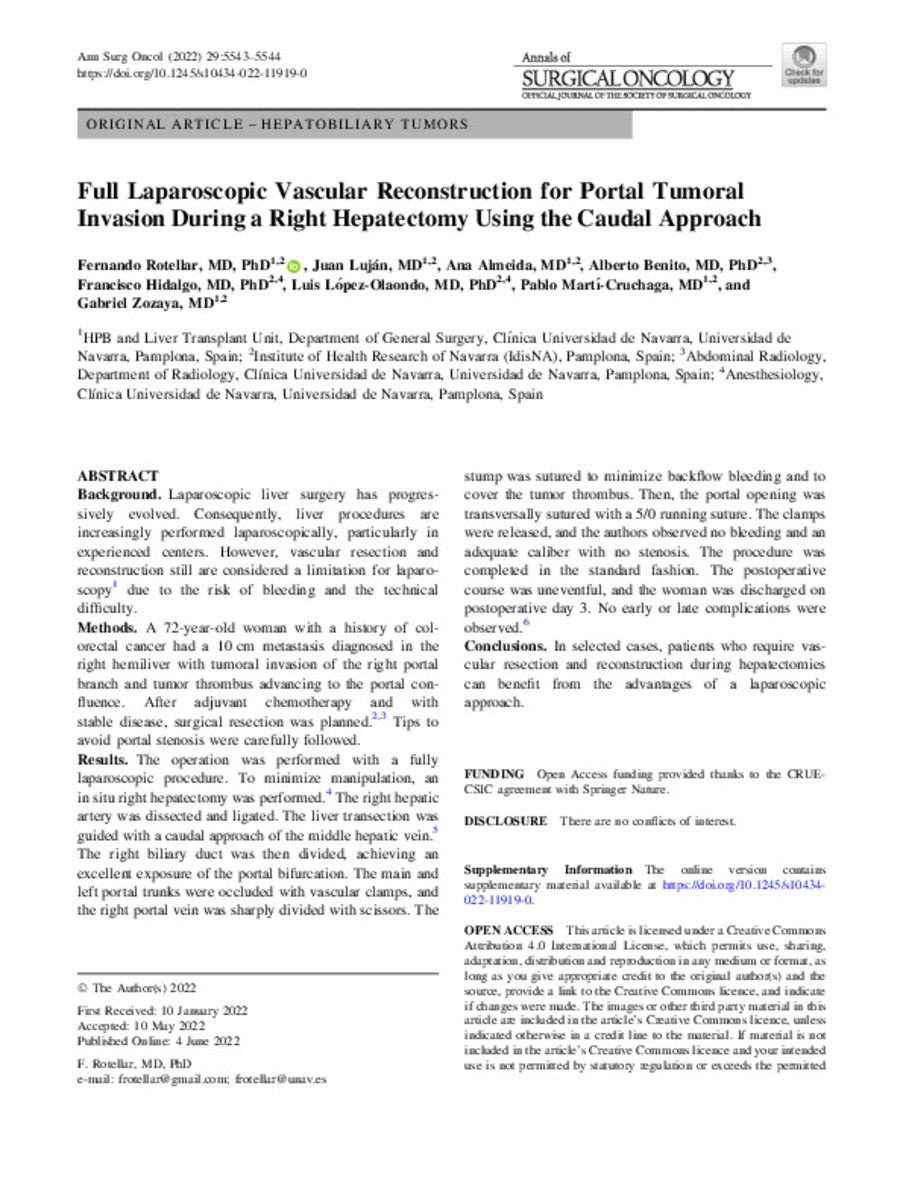Full metadata record
| DC Field | Value | Language |
|---|---|---|
| dc.creator | Rotellar, F. (Fernando) | - |
| dc.creator | Lujan-Mompean, J.A. (Juan Antonio) | - |
| dc.creator | Almeida, A. (Ana) | - |
| dc.creator | Benito-Boilos, A. (Alberto) | - |
| dc.creator | Hidalgo, F. (Francisco) | - |
| dc.creator | Lopez-Olaondo, L. (Luis) | - |
| dc.creator | Marti-Cruchaga, P. (Pablo) | - |
| dc.creator | Zozaya-Larequi, G. (Gabriel) | - |
| dc.date.accessioned | 2023-02-21T13:08:26Z | - |
| dc.date.available | 2023-02-21T13:08:26Z | - |
| dc.date.issued | 2022 | - |
| dc.identifier.citation | Rotellar, F. (Fernando); Luján, J. (Juan); Almeida, A. (Ana); et al. "Full laparoscopic vascular reconstruction for portal tumoral invasion during a right hepatectomy using the caudal approach". Annals of Surgical Oncology. 29 (9), 2022, 5543 - 5544 | es_ES |
| dc.identifier.issn | 1534-4681 | - |
| dc.identifier.uri | https://hdl.handle.net/10171/65524 | - |
| dc.description.abstract | Background: Laparoscopic liver surgery has progressively evolved. Consequently, liver procedures are increasingly performed laparoscopically, particularly in experienced centers. However, vascular resection and reconstruction still are considered a limitation for laparoscopy1 due to the risk of bleeding and the technical difficulty. Methods: A 72-year-old woman with a history of colorectal cancer had a 10 cm metastasis diagnosed in the right hemiliver with tumoral invasion of the right portal branch and tumor thrombus advancing to the portal confluence. After adjuvant chemotherapy and with stable disease, surgical resection was planned.2,3 Tips to avoid portal stenosis were carefully followed. Results: The operation was performed with a fully laparoscopic procedure. To minimize manipulation, an in situ right hepatectomy was performed.4 The right hepatic artery was dissected and ligated. The liver transection was guided with a caudal approach of the middle hepatic vein.5 The right biliary duct was then divided, achieving an excellent exposure of the portal bifurcation. The main and left portal trunks were occluded with vascular clamps, and the right portal vein was sharply divided with scissors. The stump was sutured to minimize backflow bleeding and to cover the tumor thrombus. Then, the portal opening was transversally sutured with a 5/0 running suture. The clamps were released, and the authors observed no bleeding and an adequate caliber with no stenosis. The procedure was completed in the standard fashion. The postoperative course was uneventful, and the woman was discharged on postoperative day 3. No early or late complications were observed.6 CONCLUSIONS: In selected cases, patients who require vascular resection and reconstruction during hepatectomies can benefit from the advantages of a laparoscopic approach. | es_ES |
| dc.description.sponsorship | Open Access funding provided thanks to the CRUE-CSIC agreement with Springer Nature. | es_ES |
| dc.language.iso | eng | es_ES |
| dc.rights | info:eu-repo/semantics/openAccess | es_ES |
| dc.subject | Laparoscopic vascular reconstruction | es_ES |
| dc.subject | Portal tumoral invasion | es_ES |
| dc.subject | Right hepatectomy | es_ES |
| dc.subject | Caudal approach | es_ES |
| dc.title | Full laparoscopic vascular reconstruction for portal tumoral invasion during a right hepatectomy using the caudal approach | es_ES |
| dc.type | info:eu-repo/semantics/article | es_ES |
| dc.description.note | This article is licensed under a Creative Commons Attribution 4.0 International License | es_ES |
| dc.identifier.doi | 10.1245/s10434-022-11919-0 | - |
| dadun.citation.endingPage | 5544 | es_ES |
| dadun.citation.number | 9 | es_ES |
| dadun.citation.publicationName | Annals of Surgical Oncology | es_ES |
| dadun.citation.startingPage | 5543 | es_ES |
| dadun.citation.volume | 29 | es_ES |
Files in This Item:
Statistics and impact
Items in Dadun are protected by copyright, with all rights reserved, unless otherwise indicated.






